Thu, 31 Jul 2014 . Last updated Fri, 13 Mar 2015 15:53
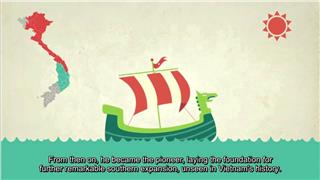
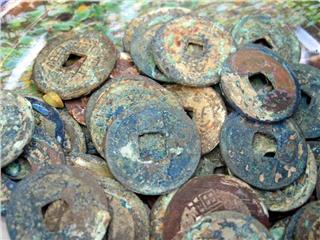
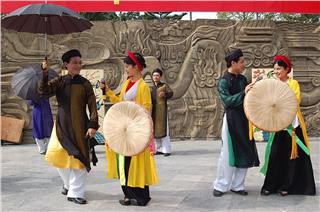
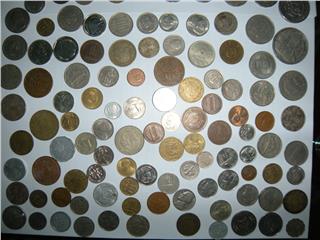
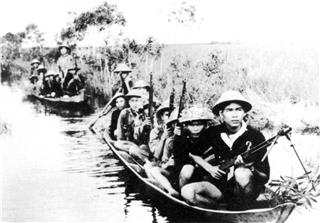
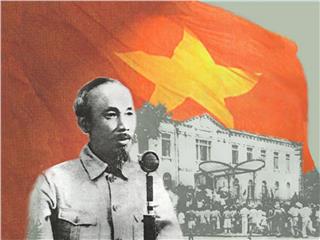
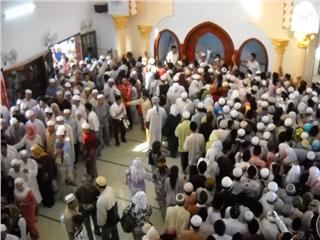


The Vietnam history wrote that this nation lived in the wars more than in the peace, they automatically know how to exit the cruel fate and regain things belongs to them. From the generation to another generation, the experience of wars helped Vietnamese people to see clearly the true face of every enemy despite sophisticated camouflaged. Therefore in the thousand-year history, the types of enemies whether were devious, sinister or brutality, when setting foot on the strip must have tasted in turn their enduring and fierce resistance.
In the last half of the 20th century, Vietnam became a quagmire buried the most modern invasive doctrines. The forest protects troops, the forest surrounds enemies. The empire was the more expanded and escalated the war, the Vietnam battlefield became the endless quagmire encircling and binding the heel of the expeditionary army. More artful than China, the United State always found the way “sitting still to observe other countries”. They only really joined in the war when the correlation military was clear or the participation of the U.S. military would play crucial role on the final outcome being profitable for them.
However, in hundreds of times intervening by the military aboard, the United State couldn’t be active as the familiar wish in several times. The first time, they sat still for 2 years after the fascist faction had started the Second World War, from Europe to Asia and Africa, the United State would not dally if the Pearl Harbor battle didn’t happen in December 1941. The air force of Japanese Navy fascists attacked unexpected the Pacific fleet of America, destroyed heavily the warships, aircrafts and crews. More than 2.300 bodies of American soldiers counted after 90 – minute attack of Japanese troops. President Roosevelt and the US Congress could not continue to stand in the margin of the fight.
The second time, in the Indochinese battlefield, the US government could not keep the stately mask of the democracy. After the French colonists defeated consecutively since 1950 and the Dien Bien Phu battle put an end the presence of the colonial troops. The US the arranged the French withdrawal in the honor on the Geneva conference table, but they stepped on the French footsteps 10 years later. From 1955 to 1965, America expected that they would set up a government of the free world in the South Vietnam.
As been fairly successful in South Korea, with the tile was Ly Thua Van and then Park Chung Hee, but the problem in the South Vietnam was completely wrong right from the supposition of the topic. All tiles of America from Bao Dai, Tran Trong Kim, Ngo Dinh Diem to the thing called the second socialist later, all didn’t converge enough justness factor to become a bright image in the heart of Vietnamese people. The Vietnamese people at that time knew only Ho Chi Minh government who led the fight against the French and Japan to regain the independence, reunification from the North to the South.
Most American veterans including Westmoreland – the general was revengeful about the failure of the US army until he died, later realized that they entered the Vietnam War like entering the quagmire without exist. But at that time, the US government and their allies still thought that they could create the dominoes, the anticommunist outposts to prevent the spread of the red wave.
On June 4th 1954, before Geneve Agreement was signed, French government unilateral agreement granting independence to Bao Dai. In fact, the last king of Nguyen dynasty abdicated from 1945 after the Democratic Republic of Vietnam government was established. Two weeks later, the exiled Head of State issued the Decree to appoint Ngo Dinh Diem - another exiled person as Prime Minister. He was in charge of leading the zombie called the Southern autonomous government that was founded in 1946 by D’Argenlieur, the French high commissioner in Indochina to sabotage the Pontainebleau peace treaty. This is a dubious and tortuous move muscle and former Emperor Bao Dai himself had to say “that called the Bao Dai solution turned out the solution of the French”.
In September, 1954, General Nguyen Van Hinh refused the command of Ngo Dinh Diem, he asked for help of Bao Dai. The exilic head of state summoned Diem to France, but Diem didn’t go. Bao Dai called from France, resigned the Prime Minister of Ngo Dinh Diem. This command was completely ineffective because the nominal position created to tug the former Emperor Bao Dai in 1946 did not also have any effect yet.
On November 17th 1954, the first cinese governor of America to Saigon to help Ngo Dinh Diem was General Colin. The puppet army at that time started to study the American program, the uniform and army rank based on the American style. Another general who was famous for slaughtering guerrillas meanwhile in Philippines also to Saigon helped Diem destroy opposing factions and pacify the South Vietnam.
From February to June 1955, getting the support of American, Ngo Dinh Diem destroyed the whole Dai Viet Party in Quang Tri, remnants of Kuomintang in Quang Nam, Binh Xuyen forces in near Saigon with 10000 troops, Hoa Hao forces in Dong Thap with 10 000 troops and Cao Dai forces in Tay Ninh having over 15000 troops.
October 1955, Diem held the referendum committee in Saigon, forced more than 7millions people in Saigon and adjacent areas deposing Bao Dai and voting him as the head of state. After the new head of state announced the establishment of the new Republic of Vietnam regime with slogan “against the colonists, eradicate the feudal and destroy the communism”. Countries including America, Britain, Australia, Japan and Spain immediately recognized the government of the South Vietnam.
On January 11th 1956, Diem issued the law 5 that allowed arresting any people threatening the security of the Republic of Vietnam and started the campaigns “denouncing communist and destroying communist”. From 1955 to 1958, Diem held thousands of large and small operations to arrest and to kill everybody having opposition mind. Their main aim was to find and destroy the party officers and members.
There were about 68,000 communists killed, 46,600 people arrested. The machinery of Diem government within 3 years tortured 68.000 people, detained 40.000 people. In the zone 5, there were 70 percent the commune commissioners, 60 percent district commissioners, 40 percent provincial commissioners arrested or detained. In particular, Tri Thien just left 160 in the total of 423.000 communist party officials and members. Khanh Hoa province had 300 party members arrested and killed. Can Tho, Soc Trang, Tra Vinh had 12.270 party members arrested or killed. Ben Tre only left 162 members, Tien Giang left 92 members. Gia Dinh, Bien Hoa, each place left one cell. This was the most overcast and gloomiest of the Southern revolution.
Despite predicting this situation right in 1954 after the Geneva Agreement, the communists and the Democratic Republic of Vietnam still took some time to form a proper orientation for the resistance in the South. After regrouping the armed forces to the north of the Parallel 17, the South Party Committee tried to preserve and rebuild the revolutionary bases. By October 1957, before Le Duan went to the North to chair the Secretariat, he had established in the South 37 guerrilla armies including officials, soldiers who had joined in the resistance against the French colonists, recruited the breakaway forces of Cao Dai, Hoa Hao, Binh Xuyen ready to protect the legitimate struggle of the Southern compatriots.
The more Diem suppressed and arrested, the more the spontaneous movement rose up. The revolutionary cadres faced the secret security system to protect bases and enlightened and manipulated the breakaway forces. In May 1959, Ngo Dinh Diem issued the Decree No.10/59 to establish the special army court, put the party members out of the law. This type of court just judged fast and the maximum time was 3 days. It didn’t apply the mitigated terms, didn’t have the lawyers, and didn’t have the right to appeal against the decision. The people and action was very vague that was called “disturb the public order”. It gave only 2 penalties: death penalty or hard labor for life. This was the pinnacle of a regime called “the dictatorship - Tutalit talit ” by the language of the Western civilization.
Diem and apparatus of his nepotism after destroying, arresting and sowing the fear to all corners from the urban areas to rural areas of the South established a puppet parliament and forced this agency through the Decree no.10/59.
Previously, the guillotine was the tool used to terrorize the Vietnamese patriotic movements of the French colonists, now it was used again by Diem and his brothers and became the typical image of the Republic of Vietnam regime. The regime of Ngo Dinh Diem and his family included Ngo Dinh Can – the locals often called Cau Can, retaining the advisor, Bishop Ngo Dinh Thuc – the Archbishop of Hue Diocese and especially Ngo Dinh Nhu, Tran Le Xuan being in charge of the security advisors. At this time, this regime revealed the nature of the authoritarianism.
Diem and Nhu founded the Can Lao party since the last of 1954. The aim of this party was the humanism. Its operation closely resembled the operation of Hitler’s Nazi party. All ruling system from Saigon to provinces, districts, communes, villages must swear loyalty to the party. Until 1959, the ruling system had 1.500 members “Can Lao Nhan Vi”. When the dictatorship reached its peak, it could only hear the echo by itself and satisfied to this. It challenged everything all round.
When the oppression was more and more growing, the opposition of the society was more and more intense. After the Decree No.10/59, the resurgent Sothern people not only stop at the struggles of political goals, democracy ordinary people’s life but also had the antagonism. The rage spread out most society, the heaviest region was in rural and farmers.
The outline of the South revolution was drafted by Le Duan and the South Party Committee since 1956, at this time, it promoted its exact and authenticity. The outline affirmed that the only revolutionary way of the Southern compatriots was revolution and erased the colonial regime and lackeys.
The revolutionary situation asked for the political fights in the high level and bringing the opposition combining with the fights. In January 1959, the South Party Committee appointed Phan Van Dang and Pham Van Xo to join in the 15th Central Party Conference. In this conference, along with Le Duan, the representative of the Party Committee prepared and was passed through the important resolution about the revolutionary way.
In 1960, Ben Tre held the general uprising marking the exploit of the South revolution. Starting from the small uprisings in 1959, the general uprising aimed to regain the power in the rural with slogans: “destroyed cruel the landlord, destroyed the grip, liberated the rural, owned the land”. The uprising forces established the administration, organized the forces. From January 7th to 24th 1960, 47 communes in Mo Cay, Rong Chom, Chau Thanh, Ba Tri, Thanh Phu rose up. The uprising forces regained many villages, of which completely owned 22 communes. From Ben Tre, the uprising spread out the entire South, the Central Highlands and Central. America-Diem fight back, but they could not stamp out the spirit of Ben Tre. The spirit of Ben Tre uprising was heartening every locals, every class, from rural areas spread out the urban areas. The dictatorial regime of Ngo Dinh Diem struggling for 3 years with barbaric attacks did not pull the political correlation in the South Vietnam.
Clearly, in the eyes of southerners had no puppet regime controlled by the United States. On December 20th 1960, at the Tan Lap commune, Chau Thanh district, Tan Bien today, in the base of Tay Ninh province, Southern Vietnam National Liberation Front called Liberation Front was formally established. Original leaders consisted of Vo Chi Cong, Doctor Phung Van Cung and architect Huynh Tan Phat.
Huynh Tan Phat served as vice president and secretary general of the central committee. Just as the birth of Viet Minh front in the period against the French, the birth of the national liberation front put the correlated politics and foreign relations in South Vietnam into a new phase. The South Vietnam battlefield since then was like a matrix encircling and destroying any interventional conspiracy, long-term partition Vietnam. Since its foundation, the liberation front held and led constant activities against the puppet government, against the U.S. and allied intervention.
On February 15th 1961, the Southern Liberation Army was established. In May 1961, U.S. Vice President Johnson hurried flight to Saigon to talk with Ngo Dinh Diem of the plan increasing weapons, number of troops, aid and advisor and to discuss the possibility of U.S. troops intervening directly in South Vietnam. Many American researchers tracked Diem since he studied at the denominational school in New York thought that totalitarian ways building one totalitarian political system in South Vietnam to destroy other political factions was the rift between Diem and U.S. government.
Despite being the frenzied anti-communism, Diem did not endorse the direct intervention of the U.S. Army. Johnson did not hesitate to give the rude comments: “Damn, Diem was the only kid that we got into”. General Taylor later wrote in his memoirs confirmed Johnson said we must destroy Diem because he was not good, we must overthrow him and we did that. The strategic intelligence that the South Central Bureau infiltrated into family Ngo was Pham Ngoc Thao Colonel, before sacrificing in 1965, he also thought that Diem was able to capitalize to prevent the landing of the U.S troops.
Come back to the situation after the uprising and establishment of the Liberation Front. Only a short time the Liberation Front and Army controlled largely rural areas and influence firmly into intermediate components in large urban areas. The General Executive Committee Politburo in Hanoi early 1961 decided to elevate Southern Party Committee to South Central Administration meaning the extended arm of the central committee and the central committee decided to bring the total force direct presence in the Southern battlefield.
October 1961 at the Ma Da base in the Southeast, Tri An today, the South Central Administration held the first meeting including Nguyen Van Linh (Muoi Cuc), Pham Van Xo (Hai Xo), Pham Thai Buong (Ba Buong), Vo Van Kiet (Sau Dan), Nguyen Don, Vo Toan, Vo Chi Cong (Nam Cong), Tran Luong, Tran Lang Trung, Hai Hau, Tran Van Quang (Bay Tien), Phan Van Dang, Hai Van, Truong Chi Cuong, Le Quang Thanh (Tu Thanh). The conference elected the Standing Committee including 6 people. The secretary was Nguyen Van Linh, the deputy secretary consisted of Vo Chi Cong and Phan Van Dang and the standing members were Le Quang Thanh, Pham Van Xo and Tran Luong. Nguyen Don and Truong Chi Cuong were appointed the secretary and deputy secretary of the zone 5. Especially, the meeting decided to establish the T1, T2, T3, T4 replacing the previous joint committees and decided to move the base from Ma Ba to the north of Tay Ninh.
November 1961 after repeatedly held rescues, finally Phu Yen armed forces also saved lawyer Nguyen Huu Tho to the Duong Minh Chau base in Tay Ninh. Lawyer Nguyen Huu Tho was the typical character of the patriotic anti-American organizations and the puppet government in Saigon imprisoned by Ngo Dinh Diem regime in Phu Yen in 1954. At the northern Tay Ninh revolutionary bases, December 16, 1962 in the First Congress, 80 delegates representing political parties, unions, ethnic groups, religion, liberated armed forces and many other typical intellectuals elected law Nguyen Huu Tho as the chairman of the central national liberation front of South Vietnam, the vice president was Phung Van Cung, Vo Chi Cong, Huynh Tan Phat, Ibialeo, Dai Duc Son Vong, Tran Nam Chung, the secretary general was Nguyen Van Hieu, the commissioners of presidium were Tran Bach Dang , Phan Van Dang, Nguyen Huu The, Tran Buu Kiem, Nguyen Thi Dinh, monk Thich Thien Hao, Ngoc Dau Su – Nguyen Van Ngoi, Le Quang Thanh, Dang Tran Thi, the front made a declaration and 10-point action plan with the aim of representing the Southern people’s interests in the struggle against American and Southern Republican administration to unify the country.
Source: YouTube.com under Creative Commons

 Đặt vé máy bay cho người Việt?
Bấm vào đây
Đặt vé máy bay cho người Việt?
Bấm vào đây
Our service uses cookies for technical, analytical and marketing purposes. See our Cookie và Privacy policies for more information. If you agree to this, just keep browsing.


